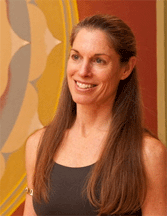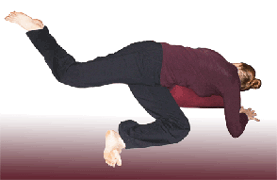By Bernie Clark, October 13th, 2013
At a recent Yin Yoga Anatomy retreat where Paul and Suzee Grilley waxed eloquently about  our bodies, our unique skeletal manifestations, and what this uniqueness means to us as students of yoga, Suzee guided us every morning through our Yin Yoga practice. While we marinated in our own sauces, she explained several ways we could improve the effectiveness of what we were doing to ourselves. Suzee’s cues are worth sharing, beginning with three key statements about Targeted Areas (TA).
our bodies, our unique skeletal manifestations, and what this uniqueness means to us as students of yoga, Suzee guided us every morning through our Yin Yoga practice. While we marinated in our own sauces, she explained several ways we could improve the effectiveness of what we were doing to ourselves. Suzee’s cues are worth sharing, beginning with three key statements about Targeted Areas (TA).
- What is the Targeted Areas you are trying to affect?
- What are you actually feeling in the Targeted Areas?
- If you are not feeling the pose where you want to feel the pose, change what you are doing and find a pose that creates the desired feeling.
We will look at these three cues as they apply in a Yin Yoga practice. A Targeted Area could be any of seven or more regions of the body where we want to focus our attention. There could be more TAs of course, especially if you are applying these concepts to the broader yang forms of yoga, but generally this number is sufficient to physically work your body from the navel to the knees, which is where we focus in Yin Yoga, and to maintain health and range of motion. The concept can be broadened to include non-physical intentions as well, such as moving energy, paying attention closely to sensations, or deepening meditation.By thinking of your yoga practice this way you will naturally evolve a functional approach to yoga over a purely aesthetic or performance related view. If your goal is to maximize your ability to perform certain postures or gymnastic maneuvers then, by all means, continue to follow an aesthetic practice, but if your intention in doing yoga is to recover, maintain or improve health, a functional approach is essential. This applies whether the practice is yin or yang.
Often in a yoga class, a focus on the posture creeps into the cues given by the teacher. This is understandable because the postures are the tools we use, but the intention behind any posture should be to generate an effect in the body, not to simply perform the posture or look good doing so. This is the main difference between a functional approach to yoga and an aesthetic approach. When a teacher, or the student herself, starts to judge the pose by what it looks like, rather than what it feels like, then the intention of optimizing health is lost. How you look in a pose is irrelevant: what is important is what you feel in the pose. Remember:
We don’t use the body to get into a pose …
We use the pose to get into the body.
Realizing this simple fact can free us up from dogma and images of perfection, and allows us to deal with the body we have and what we are really trying to accomplish in our yoga practice. With this as background, we can begin to apply Suzee’s Cues: lets look at 7 key Yin Yoga Targeted Areas and see what poses can be used to work into these areas. A table can help. In this table we have listed postures that can stress each Targeted Area – and this stress can come in two forms: compression of the tissues; or tension, which means a feeling of stretch in the Targeted Areas.
| Target Area | Easier Poses (1) | Harder Poses (1) | Meridians |
| Quadriceps & Hip Flexors | Swan, Half-Saddle, Cat’s Tail | Saddle, Dragons, Camel | For Quads: Spleen & Stomach For Hip Flexors: Liver |
| Hamstrings | Half-Shoelace, Half-Butterfly, Butterfly, Caterpillar | Dangling, Half-Frog, Snail, Dragon Splits | Urinary Bladder & Kidneys |
| Adductors | Half-Butterfly, Butterfly, Straddle (Dragonfly), Happy Baby | Half-Frog, Frog | Liver & Kidneys |
| Glutes and IT band | Swan, Deer, Half-Shoelace, Shoelace, Happy Baby, Twisted Roots – rolling to the side of the top leg | Winged Dragon, Square Pose, Reclining Twist with top leg straight to side | Gall Bladder |
| Front/Stomach – Tension (2) | Sphinx, Seal, Half-Saddle, Swan | Saddle, Camel | Stomach & Spleen |
| Back of Torso – Tension (2) | Child’s Pose, Half-Shoelace, Half-Butterfly, Butterfly, Caterpillar | Dangling, Half-Frog, Snail | Urinary Bladder & Kidneys |
| Side of Torso | Bananasana, Deer, Reclining Twists, Twists while in seated poses | Side Bends in: Shoelace, Half-Butterfly, Saddle or Straddle (Dragonfly) | Gall Bladder |
1 — For descriptions of these poses and options, visit our Yin Yoga Asana page.
2 — For compression of these areas, use the poses that create tension of the other side: to compress the stomach use the poses that stretch the back, and vice versa
This list is not exhaustive, and there may be many other poses that help you get the stress you want in a certain Targeted Area, but as you have just seen, you don’t need a really large vocabulary of postures to work the body effectively. Fortunately, as shown above, if one pose just doesn’t quite do it for you, there are other poses you can try. For example, if you just don’t feel the outside of your hips in Shoelace, but your TA is the glutes and IT band, then try one of the other poses. Maybe Square Pose is just what you need.
 Moving away from an aesthetically pleasing alignment is allowed! Feel free to wiggle. Move around in any of these poses to see if some slight or more dramatic adjustment creates the sensations you are after. Remember, it doesn’t matter what you look like – as long as there is no pain present, who cares what you look like? Go to where there is an edge. Sometimes the adjustment you need may be very minor. Maybe just using a block or a bolster will give youthe support needed to find the edge. Sometimes all you need to do is back off a little bit. Surprisingly, for some people backing out of a pose a little generates more sensation than going to the ultimate limit of their range of motion. You don’t always have to have your legs as far apart as possible in Straddle Pose (Dragonfly), for example. Keeping the legs closer together may work some parts of your adductors that you have been overlooking all these years.
Moving away from an aesthetically pleasing alignment is allowed! Feel free to wiggle. Move around in any of these poses to see if some slight or more dramatic adjustment creates the sensations you are after. Remember, it doesn’t matter what you look like – as long as there is no pain present, who cares what you look like? Go to where there is an edge. Sometimes the adjustment you need may be very minor. Maybe just using a block or a bolster will give youthe support needed to find the edge. Sometimes all you need to do is back off a little bit. Surprisingly, for some people backing out of a pose a little generates more sensation than going to the ultimate limit of their range of motion. You don’t always have to have your legs as far apart as possible in Straddle Pose (Dragonfly), for example. Keeping the legs closer together may work some parts of your adductors that you have been overlooking all these years.
You can see how using a functional approach to yoga and this simple table make it really easy to design a Yin Yoga flow: just pick a TA or two to focus on, select one easy and maybe one harder pose, and you are all set. If the selected poses aren’t working, try one of the other offerings.
Of course you can add some upper body Target Areas as well, such as shoulders, and arms. Knowing the process, adding those on your own is simple. And you can expand this process to add in your yang yoga repertoire. The philosophy is the same whether your practice is yin or yang: by adopting a functional approach to your yoga practice you are much more likely to successfully achieve your intention of optimizing health while minimizing the risk of injuries.
The functional approach to yoga also leads directly to another realization: your body needs your yoga. Focus on aesthetics has led the yoga world into a focus on alignment cues instead of functional cues. Since every body is different, how can one set of aesthetic cues work for every body? Unfortunately, it can’t – but that is a topic for another article. If you are interested in following the implications that flow from a focus on functional yoga further, please read our next article: Your Body – Your Yoga.
(Back to Newsletter #17)